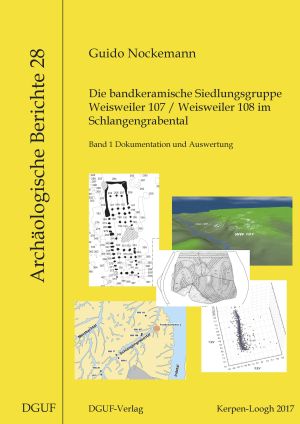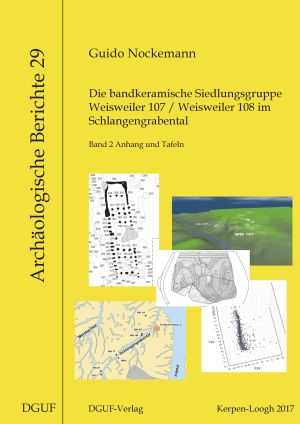Nockemann, Guido
Die bandkeramische Siedlungsgruppe Weisweiler 107 / Weisweiler 108 im Schlangengrabental: Band 1. Dokumentation und Auswertung
The Aldenhover plate came into the focus of the Bandkeramik research 40 years ago. Before the digging of soft coal, countless excavations and prospection were and still are being made. This book is about the archaeological findings and evaluation of the Bandkeramik settlement of Weisweiler 107 and Weisweiler 108 in Schlangengrabental on the Aldenhover plate situated in the Rhineland. This publication aims to not only document the bandkeramik legacy but also to accentuate the specialities and characteristics of the settlements Weisweiler 107 and Weisweiler 108. Furthermore this book attempts to clarify the cultural historical position and function of the Rhineland Bandkeramik. In order to do that, the findings are being compared with other settlements. Moreover a chronology of the settlement is complied and its role in different networks e.g. ceramic decorations or trading of flint artefact is analysed. This project closes a gap. For the first time all of the known settlements of the Bandkeramik age of the Schlangengrabental are documented and analysed as one.
Volume Archäologische Berichte 29 documents the data and the research.
Die bandkeramische Siedlungsgruppe Weisweiler 107 / Weisweiler 108 im Schlangengrabental: Band 2. Anhang und Tafeln
The Aldenhover plate came into the focus of the Bandkeramik research 40 years ago. Before the digging of soft coal, countless excavations and prospection were and still are being made. This book is about the archaeological findings and evaluation of the Bandkeramik settlement of Weisweiler 107 and Weisweiler 108 in Schlangengrabental on the Aldenhover plate situated in the Rhineland. This publication aims to not only document the bandkeramik legacy but also to accentuate the specialities and characteristics of the settlements Weisweiler 107 and Weisweiler 108. Furthermore this book attempts to clarify the cultural historical position and function of the Rhineland Bandkeramik. In order to do that, the findings are being compared with other settlements. Moreover a chronology of the settlement is complied and its role in different networks e.g. ceramic decorations or trading of flint artefact is analysed. This project closes a gap. For the first time all of the known settlements of the Bandkeramik age of the Schlangengrabental are documented and analysed as one.
Volume Archäologische Berichte 28 presents the analysis and results.








